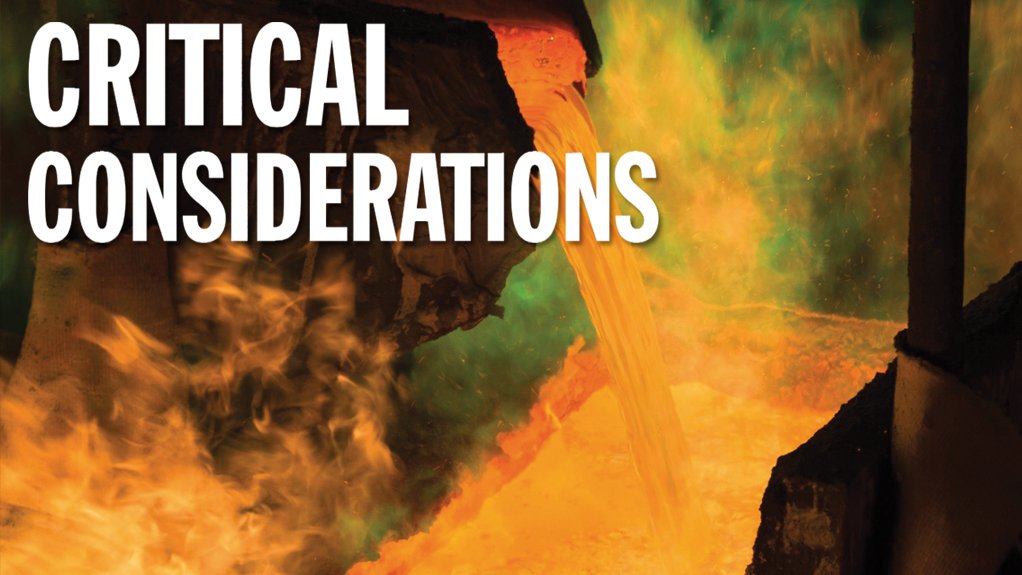Unpacking the conditions for meeting burgeoning copper demand
With copper demand expected to increase from 28.3-million tonnes in 2020 to 41-million tonnes by 2040 at a compound yearly growth rate of 1.85%, and many regions gearing up supply chains for critical metals, JSE- and ASX-listed Orion Minerals CEO and MD Errol Smart says it will be the responsible mining companies that will rise to the demand challenge and be competitive in the market.
Copper mining sites globally have “less than satisfactory” environmental and social management practices, but funders and offtakers are increasingly supporting mining companies with solid environmental, social and governance (ESG) credentials, he tells Engineering News & Mining Weekly.
For example, Europe has imposed regulations for supply chain security that can be audited, with stakeholders requiring audit trails for feed materials used in products that are manufactured on the continent.
Smart adds there are manufacturing companies in Europe willing to invest in mining projects, to ensure a responsible and sustainable source of supply, which are the kinds of opportunities that Africa-focused miners can grasp, particularly as the West looks to build a critical metals supply chain independently of China, the current mecca of critical metals manufacturing.
There is, however, still underinvestment in new copper mines on the African continent, with competition for funding being fierce. Although there has been investment in sustaining old copper mines with poor ESG practices in place, this is not a sustainable solution to meet future copper demand, explains Smart.
Zambia and the Democratic Republic of Congo (DRC) have successfully attracted foreign investment to bring modern technology to bear, making large discoveries and sourcing financing to build high-capacity mines. Along with Botswana and Namibia, Zambia has also made “significant strides” in attracting foreign investment for mining projects, including copper mining projects, he adds.
Another emerging copper mining company that recently listed on the JSE, Copper 360, agrees with the International Copper Association (ICA) that copper is an essential element in the green economy, supporting most electrical and battery-powered devices manufactured globally.
The ICA sets out its expected copper demand trends up to 2040 in a report published on April 15, saying that copper’s future market share will be defined by regional trends and the green energy transition.
Driving Demand
Despite Europe and other regions, such as North America, introducing policies and incentives to encourage critical mineral supply chain development, the strongest growth in copper demand by 2040 is poised to come from India and Southeast Asian countries, the ICA states.
Copper demand is forecast to increase at compound yearly average rates of 7% and 6% respectively in these two markets from 2020 to 2040.
Currently China beneficiates 40% of the world’s copper, owing to strategic investments having been made in the 1990s. The country has invested in many mines globally to secure supply and build up beneficiation capabilities that are required to turn raw materials into refined metal.
The ICA expects wire rod to be the largest source of copper demand in future, owing to an influx of energy infrastructure development, comprising 25-million tonnes, or 60%, of total demand by 2040.
For its part, copper tubing will add 1.6- million tonnes to copper demand from 2020 to 2040. The association estimates that demand for air source heat pumps will quadruple, from 13-million units in 2020 to 52-million units in 2040, which is testament to the growing energy transition market.
The ICA also anticipates that there will be a slight decrease in the global market share of copper wire and cable from 2020 to 2040, owing to copper substitution. Smart says copper substitution is an “inevitable consequence”, owing to the cost of the commodity.
If copper were to trade at prices as high as $15 000/t, there are other metals that can be used at lower production costs and at scale in some instances, he explains, adding that, to sustain copper’s viability for end-users, parity pricing will be required.
To fill a potential supply gap of eight- million tons by 2034, mining companies require copper prices higher than $10 000/t and, possibly, as high as $12 000/t, elaborates commodity supplier Trafigura CEO Jeremy Weir.
Further, major copper mining company Rio Tinto believes that building mines is more cost effective than buying existing ones, and that consolidation in the industry will be logical only if it increases the supply of metal in general.
A high-profile example of possible consolidation in the works, for which copper is the central rationale, is global miner BHP’s $43-bilion bid to buy out fellow global miner Anglo American. Anglo has, however, rejected two non-binding proposals from BHP and instead published a restructuring plan of its own.
In a clear indication that BHP’s prime motive is to gain control of Anglo’s promising copper assets, the group wants Anglo to first spin off its South African platinum and iron-ore businesses before proceeding with a takeover. The acquisition would be the industry’s biggest deal in more than a decade and create the world’s biggest copper producing company, accounting for 10% of global supply.
In Anglo’s restructuring plan, it mentions its intention to sell or spin off its diamond and platinum businesses as part of a strategic restructuring to simplify its portfolio. The group is also mulling, as part of the plan, the sale of its steelmaking coal assets and nickel operations, which would result in a simpler structure comprising iron-ore and copper.
Meanwhile, Canadian miner Ivanhoe Mines, which has copper mines in the DRC, estimates the price of copper to be close to $15 000/t before the industry can viably build more copper mines.
While the copper price is currently about $10 000/t, Copper 360 CE Jan Nelson says it remains profitable at this rate. However, market predictions of significant price increases are encouraging, as the global economy is expected to demand more copper towards the end of the year and beyond.
Smart agrees, pointing out that the company’s operating cost will be in the range of $4 000/t to $5 000/t, while capital cost will be between $7 000/t and $9 000/t, compared with his expectation that the copper price will reach $12 000/t in the near term.
For now, market research organisation BMI estimates an average copper price of $8 800/t for the year, compared with an average price of $8 523/t in 2023 and $8 788/t in 2022. BMI expects copper consumption to grow by 3.5% a year to 28-million tonnes in 2024.
Consultancy PwC says “the world has entered the era of critical metals”, with copper ranked in pole position for critical metals demand, owing to the global clean energy and clean energy technologies transition.
Copper’s unique properties of high conductivity, machinability and corrosion resistance are needed across all green energy applications, including renewable-energy generation, transmission, distribution, storage and end-use, the consultancy notes.
Renewable energy generation technologies are also more copper intensive than traditional technologies, with solar PV panels, offshore wind turbines and electric vehicle charging infrastructure being key demand areas for copper.
Challenged Juniors
With Orion having managed to secure the valuable Prieska and Okiep copper projects, in South Africa, Smart says the permitting and legal framework to progress projects from discovery to mine development is a “long, costly and tiring process”.
He highlights the slow regulatory process and red tape involved in permitting, for both prospecting or mining, as being the major inhibitors for more copper exploration and development and, thereby, more economic growth.
Smart lauds Botswana, Zambia and Namibia for having very efficient licensing processes and for having transformed into “mining-friendly” countries, with increasing support from the international and continental investment community.
He believes there are many areas in Africa with untapped or stranded mineral resources that, with some positive macroeconomic movement and policy changes, can incentivise more responsible copper development.
With its portfolio of prospects in the Northern Cape, Copper 360 is among the few mining companies in South Africa that have managed to persevere amid bureaucratic procrastination. The company’s mining right covers 19 000 ha of 60 copper prospects with advanced geological datasets.
Following an upgrade of the Rietberg project’s mineral resource estimate by 220%, from 25 257 t in 2022 to 81 200 t in 2023, coupled with discoveries at the Tweefontein mine, Copper 360 estimates that the life-of-mine across its various deposits could exceed 100 years.
PwC agrees with Orion that the South African government can encourage more exploration investment with sensible regulation, available infrastructure and balanced tax regimes.
There are significant concentration risks across all areas of the critical metals value chains, including copper, and Southern Africa can emerge as an alternative source of supply for foreign investors. This could significantly reduce geopolitical supply chain risk in the global economy, the consultancy adds.
New Frontiers
Orion has been investigating metal vapour refining, particularly aimed at mixed metals. Smart says historical mining techniques have often “locked up” copper that is present alongside nickel.
The company sees opportunity to refine technology that can get high recoveries in mixed-metal deposits, which will help inform its exploration direction and mining portfolio in the longer term.
Its focus, for now, remains on the traditional discovery and production of copper concentrates.
Further, PwC stresses the need for African countries to play a role beyond primary mining of critical metals, such as copper, and scale up battery pack assembly, for example, to play a more meaningful role in the global energy landscape.
South Africa can use its metal resources to build strong partnerships across the value chain, and sustainable production should be prioritised, it says.
The consultancy echoes Smart’s view that responsible resource use and ESG in mining reduce operational risk and, ultimately, enhance shareholder value, while Copper 360 says exploration and mining activity in the Northern Cape can create thousands of jobs and unlock downstream potential of economic development.
The company is gearing up for an expected mineral boom in the province by training students – an example of the difference that responsible, or ESG-focused, mining can make in South Africa’s socioeconomic landscape.
Article Enquiry
Email Article
Save Article
Feedback
To advertise email advertising@creamermedia.co.za or click here
Press Office
Announcements
What's On
Subscribe to improve your user experience...
Option 1 (equivalent of R125 a month):
Receive a weekly copy of Creamer Media's Engineering News & Mining Weekly magazine
(print copy for those in South Africa and e-magazine for those outside of South Africa)
Receive daily email newsletters
Access to full search results
Access archive of magazine back copies
Access to Projects in Progress
Access to ONE Research Report of your choice in PDF format
Option 2 (equivalent of R375 a month):
All benefits from Option 1
PLUS
Access to Creamer Media's Research Channel Africa for ALL Research Reports, in PDF format, on various industrial and mining sectors
including Electricity; Water; Energy Transition; Hydrogen; Roads, Rail and Ports; Coal; Gold; Platinum; Battery Metals; etc.
Already a subscriber?
Forgotten your password?
Receive weekly copy of Creamer Media's Engineering News & Mining Weekly magazine (print copy for those in South Africa and e-magazine for those outside of South Africa)
➕
Recieve daily email newsletters
➕
Access to full search results
➕
Access archive of magazine back copies
➕
Access to Projects in Progress
➕
Access to ONE Research Report of your choice in PDF format
RESEARCH CHANNEL AFRICA
R4500 (equivalent of R375 a month)
SUBSCRIBEAll benefits from Option 1
➕
Access to Creamer Media's Research Channel Africa for ALL Research Reports on various industrial and mining sectors, in PDF format, including on:
Electricity
➕
Water
➕
Energy Transition
➕
Hydrogen
➕
Roads, Rail and Ports
➕
Coal
➕
Gold
➕
Platinum
➕
Battery Metals
➕
etc.
Receive all benefits from Option 1 or Option 2 delivered to numerous people at your company
➕
Multiple User names and Passwords for simultaneous log-ins
➕
Intranet integration access to all in your organisation

















